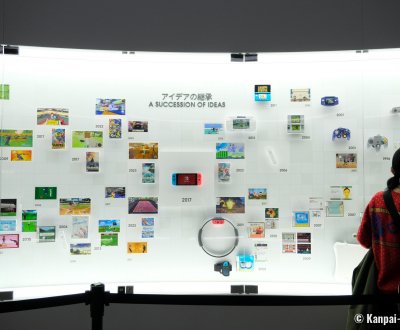Nintendo Museum
The Official Mario Museum in the South of Kyoto
Nintendo Museum is the official museum dedicated to Nintendo, located in the company’s former buildings in Uji, in the south of Kyoto in Japan. Inaugurated in October 2024, it tells the story of Nintendo, from its early days making hanafuda and karuta card games to its many successes in the video game industry. It is establishing as a new place to visit for Mario fans.
In the same spirit as the official shops opened over the recent years in Tokyo, Kyoto and Osaka, and the inauguration of the Super Nintendo World at USJ, Nintendo gamers are offered since 2024, October 2 a new authentic pilgrimage with the 1rst museum dedicated to the company’s history.
Its official name is "Nintendo Museum" and it was set up inside a former plant building of the company, initially known as "Uji Ogura Plant" and located in a residential district of Uji, a few kilometers south to Kyoto. The little city is famous for its historical and cultural heritage related to green tea cultivation and a few ancient temples, such as the Byodo-in, listed in the UNESCO World Heritage. Slightly off the city center, Ogura station on the Kintetsu Line is only a few minutes walk away from the museum, while the walk is significantly longer when coming from Ogura JR Station.
The massive building is crowned by the company’s official logo, in lavender and anthracite hues, the 2 main colors of the museum. The museography was designed avoiding a too colorful exhibition, providing a setting that is both simple and elegant where every detail is a reference to Nintendo. The central square, that gives access to the museum’s entrance and its cafe, is featuring a Mario-themed decoration, with the famous green pipes placed so that visitors can snap a souvenir picture upon arriving. A Pokémon manhole is also on display near the umbrella locker.
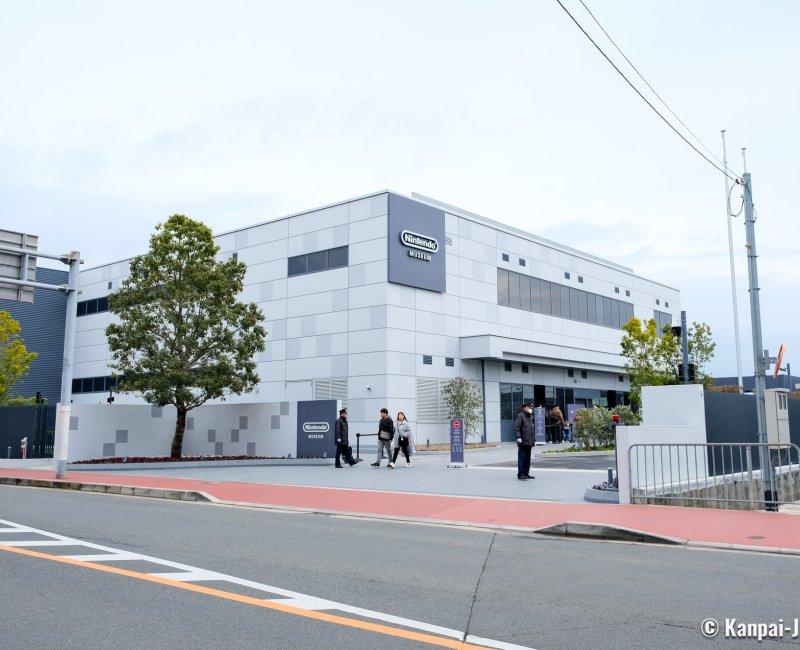
A beautiful visual and interactive exhibition
Overall, the museum is not so big, and the visit is divided into 2 parts: the tour starts at the upper floor, then goes down to the ground floor, which also has a souvenir shop.
The upper floor is home to an exceptional historic exhibition. While it is not exhaustive, it has been carefully curated to display in a chronological order and following themed subjects all the products designed by the company:
- Card games, board games and sport games, for all the family before the 1970s; then,
- Video games with the 1rst consoles produced in japan, arcade games and various video game model scales with variations sold in different countries.
For example, one can’t help feeling some sort of nostalgia rediscovering the Game & Watch pocket games that preceded the 1rst portable consoles such as the popular Game Boy. There is also a rare opportunity to have a look at the Virtual Boy experience.
This area focuses on visual information, with very few explanation, be it in Japanese or in English, which is a bit of a shame. It could have been interesting to dive in the thoughts of great video game creators, especially of Shigeru Miyamoto (Mario and Zelda’s dad, now acting as the company’s representative director) who often stars in Nintendo’s PR videos. Note that taking picture is prohibited at this floor and the staff makes sure the ruel is actually enforced.
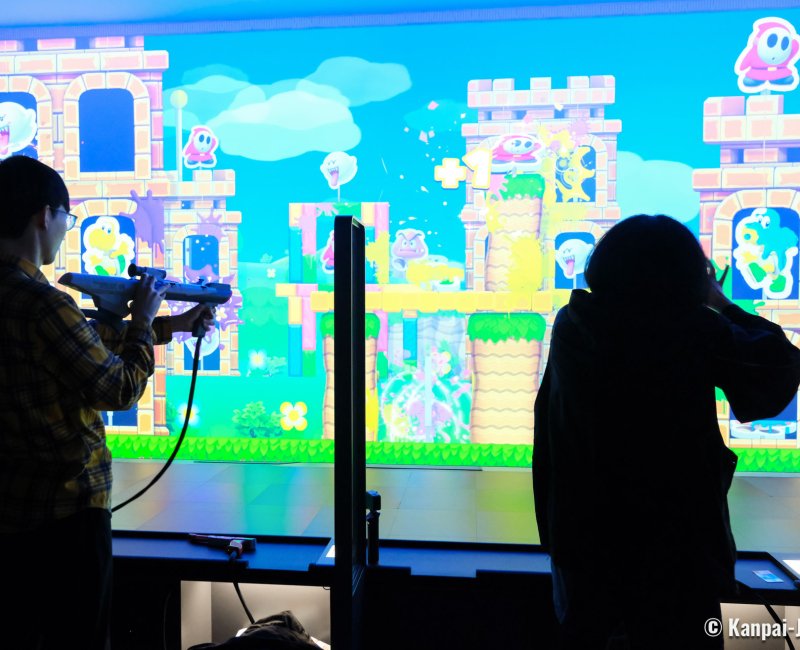
Immersed in darkness, the ground floor is a more playful area, like a kind of arcade center where various and eclectic games are available. The ¥100 coins are replaced by virtual coins that are topped up on a non-transferable card upon entering the museum. The card is cute and can be kept as a souvenir. Each visitor can spend up to 10 coins, as they please and according to the fee for each game (1 to 4 coins). This virtual sum is not enough to try all the games, so choices have to be made.
The most interesting games, as they are exclusive to the museum, are also the most "expensive" ones, such as:
- Shigureden, based on the traditional Japanese card game Hyakunin Isshu. Participants play by pairing the cards that appear through animation on the floor that is also a screen;
- Zapper & Scope, a fun shooting game (with a Zapper or a Super Scope) for up to 13 players;
- Big Controller, a game for 2 players using a quirky giant Nintendo controller (NES, Super NES, N64 or Wii); and,
- Ultra Machine, players try to hit a ball pitched by a machine in a small batting room. The game was released in 1968, before the company invested in the video game industry.
These interactive games are naturally the most popular. A waiting time is therefore to be expected, and while it is not displayed, it is possible to inquire the staff about it. An area is also dedicated to retrogaming, allowing 5 minutes playtime sessions of one of Nintendo’s classic games. The games are really fun and time flies by so fast in this interactive area. The day after the visit, players receive an email summarizing their scores.
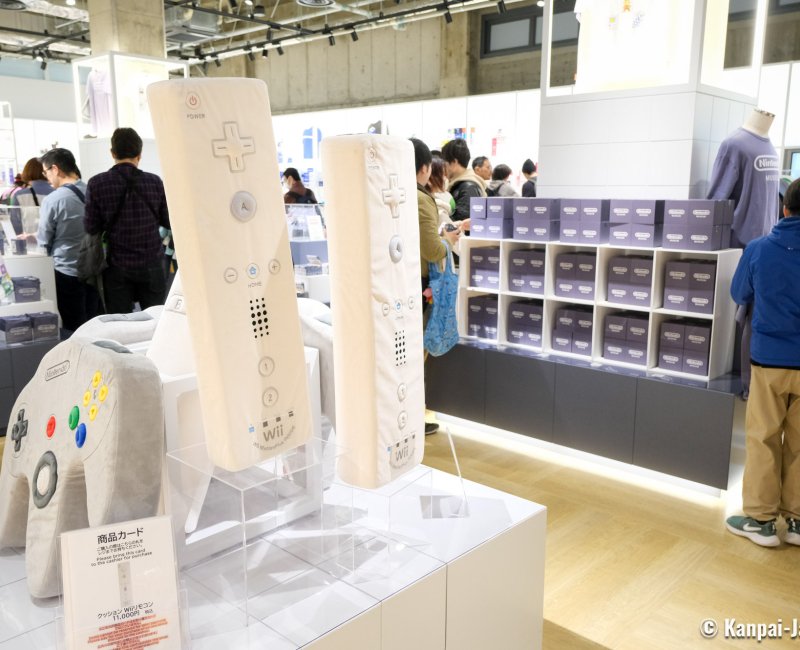
Exiting the gaming area, the tour ends at the museum’s official shop. You’ll find a lot of merchandising featuring consoles, games and characters that are already on sale at the various Nintendo stores in Japan. Museum exclusive goods, mirroring the colors of the museum, are displayed in a small number near the sales counter. Controller-shaped giant cushions are among the most quirky and bulky goods one can bring back as a souvenir. Popular products may happen to be temporarily sold out.
A minimum of 2 to 3 hours is necessary to enjoy the full tour of the exhibitions and the games. The visit can be extended with additional activities such as:
- 2 workshops to create and practice the hanafuda card game, upon paid reservation; and,
- A themed cafe serving cute burgers to assemble according to taste.
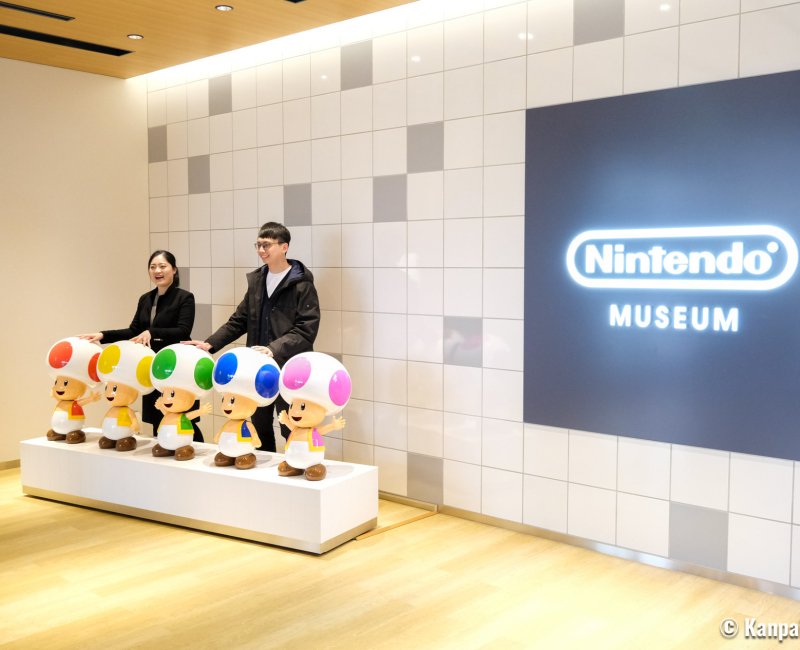
How to book tickets for the Nintendo Museum
Nintendo Museum’s tickets cannot be purchased at the door or on the same day. They must be booked in advance online using a Nintendo account (free registration here).
The official ticketing system offers 2 ways to purchase tickets:
- A lottery, to enter 3 months prior to the desired day of visit. While being drawn is not guaranteed, it is the main way to get a ticket to the museum. If the visit is planned in may, one must enter the lottery starting February 1rst;
- Purchasing non-distributed tickets is theoretically possible until the day before the visit. However, chances to get tickets this way are very small considering the museum's popularity. For the record, none of these tickets were available in winter 2025 which is a low season tourism-wise.
Regarding the drawing, the main steps are:
- 3 months before: entering the lottery with a Nintendo account. Select up to 3 dates (day and hour) and state the number of participants as well as their ages. When coming in a group, the reservation can be made by one person (the group’s leader) for everybody. The ID (first name and surname) of each participant is required, information that will be checked upon entering the museum against an ID proof (passport for international visitors). Tickets are non-transferable and cannot be given nor sold to another person.
- 1rst day of month M-2: drawing results are sent by email. If successful, the day and hour of visit selected by the museum are indicated. Reservation cannot be changed. There is a 7-days time limit to pay the tickets and secure the reservation.
- 7th day of month M-2: deadline to pay the tickets and secure the reservation. A QR Code is sent upon validation of payment.
- The day before the visit: issuing of the admission tickets using the QR Code received upon payment, available from 2 p.m. on the official website and through the Nintendo account used to make the reservation.
At the museum and before entering, the visitors’ ID is checked, and bags are carefully inspected (the same as the airport). The process takes some time so we recommend arriving ahead of the reserved hour so as not waste too much time, especially if the ticket is for the afternoon. The end of the day’s time slots (starting 3/4 p.m.) are the easiest to get as they are the least popular. Note that the ticket is valid for the whole day, and it allows exiting and re-entering the museum on the same day.

